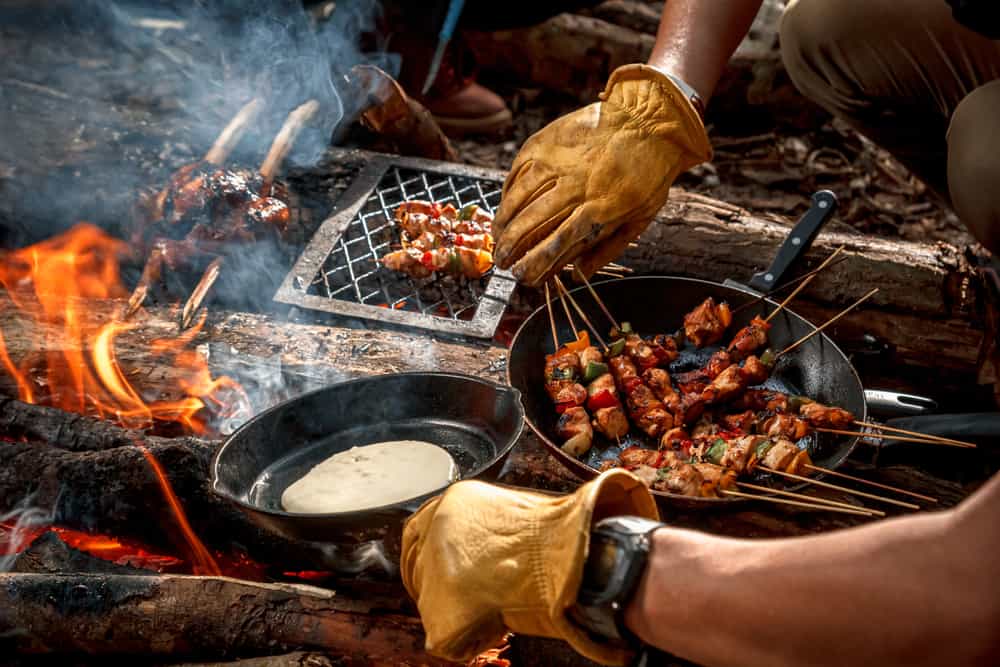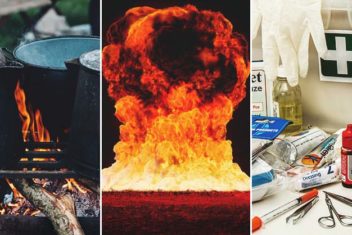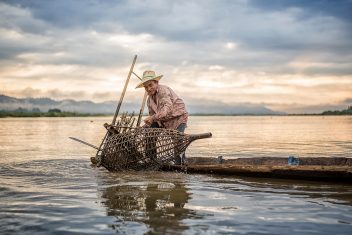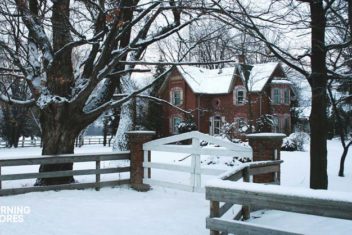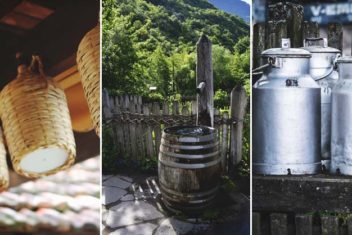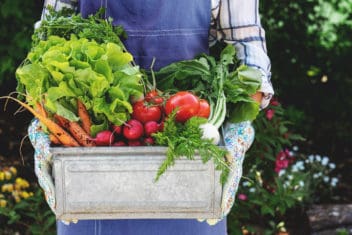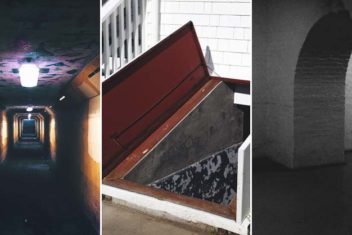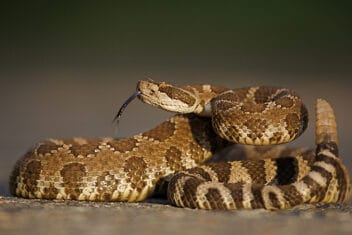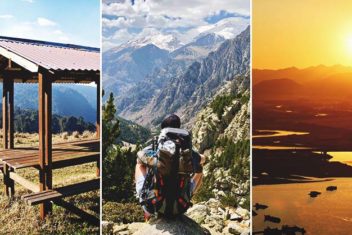There is something primal about cooking on an open fire. The heat, the smell of the smoke, and the roaring and crackling create an experience that speaks to the most basic parts of us. You’re connecting to something your ancestors did thousands of years ago.
Whether you’re camping, living off-grid, or having a family cookout, getting everything right on an open fire is not as simple as it seems. You have to get heat and timing right, to avoid over-smoking or burning the food. All this takes experience and knowledge.
If you love the thought of cooking on an open fire, and you want to do it right, let us help you make it a positive experience you’ll want to do again and again.
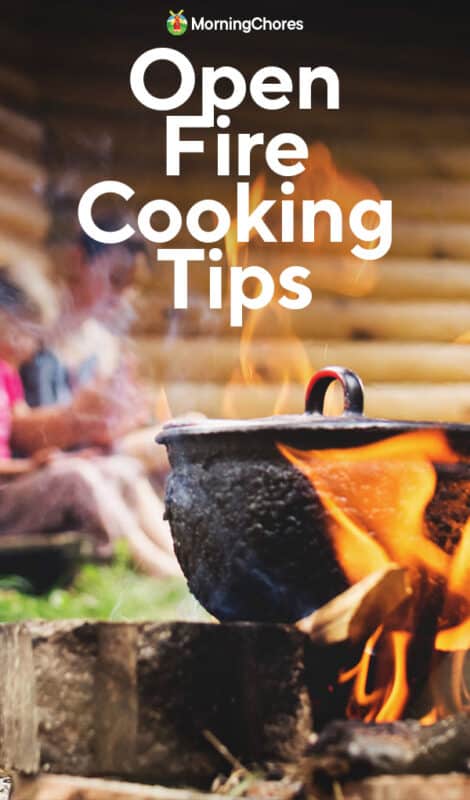
1. Use the Right Fuel
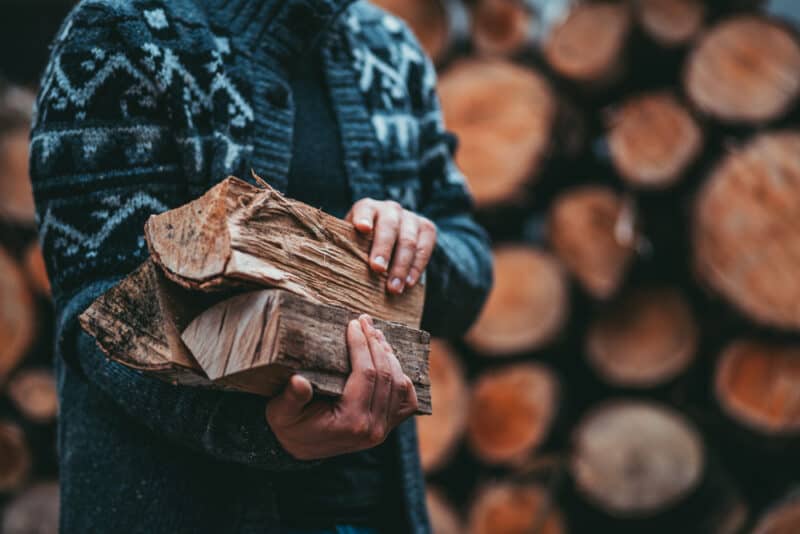
Use only seasoned firewood that has dried well. Greenwood is difficult to light and the heat will be limited. Greenwood also smokes a lot and dies out easily.
The moisture content of the wood must be 20 percent or lower. You can purchase moisture meters reasonably cheap if you’re unsure if your wood is dry enough. Over time, you’ll become familiar with wood that is good for burning as you gather it.
Use hardwoods like hickory, elm, oak, or maple. Softwoods like pine are okay if they’re well-seasoned.
2. Set the Fire Correctly
There are a number of ways to start a fire, but here is the method I prefer. Starting the perfect fire makes for the perfect cooking conditions. You really don’t want to fail to light and get a good heat building.
Start with paper, straw, and small dry twigs or thin bark. Light this small pile with matches or a lighter. Once it’s alight, add more small twigs. As the fire builds, gradually add bigger and bigger sticks.
Once you have a good size fire, begin to add larger logs. You want to make sure the fire is burning well, but don’t add new logs too quickly after the previous one otherwise you’ll smother the fire and create a lot of smoke and little heat.
Also, adding too many logs at once makes for a big fire that burns down quickly, and it may not hold enough heat in the coals.
3. Give Yourself Time
Cooking on an open fire is time-consuming. Unlike starting an oven and cooking, there is the prepping, fuel gathering, building the fire gradually, and reducing to coals to cook. Give yourself plenty of time and factor that in if you are cooking for other people.
Start earlier than you think you need to. Cooking in the dark with a headlight isn’t the most fun. It’s hard to tell whether the food is cooked, burned, or raw.
4. Cook on the Coals, Not on Flames

One of the most common mistakes many people make is cooking on the fire too soon. This is especially so when you cook directly, like placing meat on a grill over the fire. You can be forgiven for thinking it’s good to cook on a flame because it’s often how fire-cooking is portrayed on television or movies.
Flames will burn meat on the outside, leaving the inside undercooked, and will blacken your cookware.
You must make sure the fire burns down to grey coals. This is when the heat is consistent and hot. Aim for glowing embers.
5. Split The Fire for Cooking and Providing Heat
Once the fire is burning well, drag half the coals to one side and use this for cooking. Make sure there are enough coals to maintain the heat you need for the food you are cooking. Use the other side to maintain a flame for warmth, or to add to the coals as the heat dies down.
6. Use Quality Cooking Equipment
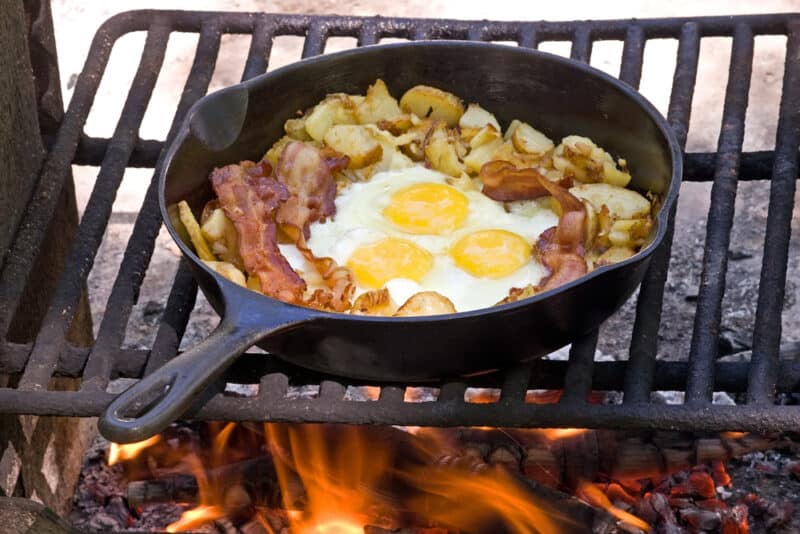
Don’t use your kitchen pots and pans on the open fire. They will get blackened and burned. Definitely don’t use your non-stick cookware. Use equipment made for open fires like cast iron. The proper pots and pans won’t negatively affect the flavor like indoor cooking equipment.
Good quality cast iron should last a lifetime.
Grill or Grate
A grill or grate on legs is perfect, but if you don’t have legs, use rocks or larger logs to hold the grill off the coals. The surface you cook on must be solid and stable. While it’s possible to cook without a grate, the job will be much easier with one and there are many different options available at all different price points.
Tripod and Chain
Remember those old western movies where they would have a pot of stew hanging from a tripod over a fire? While the technology has come further, the concept is still the same.
This is a tried and true method of cooking on an open fire and one where you can allow the food to simmer slowly. The pot is suspended over the heat and you can move the pot up and down as needed to adjust the heat.
This is one technique I love because it cooks and heats evenly and you don’t have to wait for the flames to die and turn into coals. A mixture of coals and flame is perfect.
Rotisserie
Although a little advanced, a rotisserie or spit roast is a good way to cook larger cuts of meat, or a whole animal. There are versions that you turn manually, or better yet, ones that turn automatically. The great thing about rotisseries is they cook evenly and keep the meat moist, especially if you brine first.
The turning bastes the meat in its own juices and causes the juices to drip on the hot coals and steam flavor and moisture back into the meat.
Just be wary of flames or flareups from the dripping fats and juices.
Cast Iron Dutch Oven
A Dutch oven is a pot with a lid and it holds the moisture in as your food cooks. The good thing about a Dutch oven is it can sit right in the coals, on a grill, or be suspended from a tripod. You can place the oven in the coals and put more hot coals on the lid to create a more even heat.
Dutch ovens are versatile. You can cook stews, bake bread, roast meat or veggies, fry, or simmer any type of food.
Skillet
A good quality cast iron skillet will see you cooking perfect steaks for years to come. Anything that needs frying can be cooked in a skillet. Become familiar with how to season and care for cast iron before you jump in.
7. Use Foil
If you want to skip the expensive and bulky equipment above, you can cook an entire meal of meat, potatoes, and other vegetables in an aluminum foil pack. Place it directly on the coals, on a grill, or even in a skillet. If you don’t eat meat, seasoned vegetables come out perfect in a foil pouch.
Make sure you double-layer the pack if placed directly on the coals, and flip regularly to avoid burning.
Be very careful opening the pack up because the steam from inside will be super-hot.
8. Cook on a Rock
Rocks are not only good for creating a border around your fire or for lining a fire pit. You can also cook on a rock that has a flat surface big enough for your food or skillet.
Choosing the right rocks for a fire is important. Don’t use wet rocks as they can explode as soon as they hit high temperatures. Slate and shale may explode as well.
Find out what the best rocks to use in your area are. Build your fire as normal and place a rock with a flat surface on the edge of the fire to heat up slowly. You will find that even if the fire dies down, the rock stays hot enough to cook on for hours.
If you’re feeling adventurous, you might want to try cooking over a Swedish fire log instead of using a rock.
9. Build Two Fires
This is a good idea until you are confident in cooking and maintaining heat on a single fire. The concept here is maintaining heat suitable for cooking can be hard with one fire. You get it too hot or let it die down too much and it cools so you have to place more wood on to burn down to coals again.
All the while your food is partially cooked.
You can use the second fire to add coals to the cooking fire to maintain temperatures while you cook. If the cooking fire is too hot, you will have somewhere safe to move some hot coals to.
10. Use Sticks
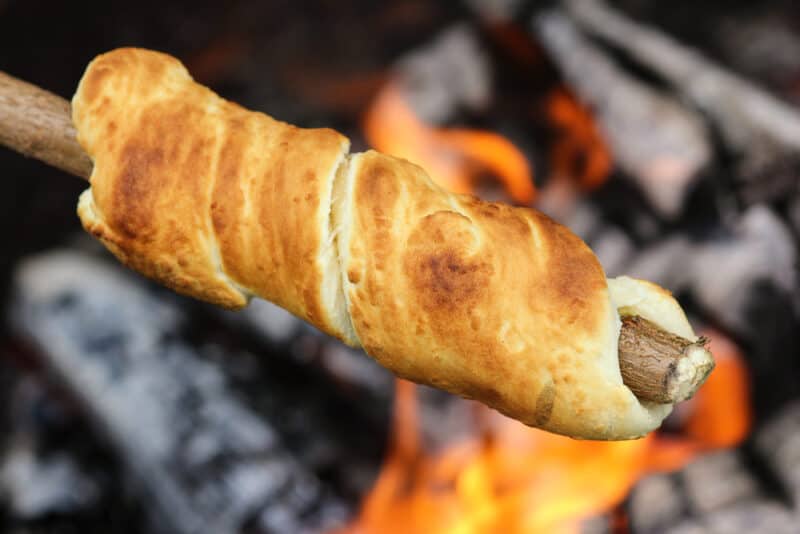
You’re probably familiar with cooking hot dogs and marshmallows on sticks, but you can cook much more.
Danish fire bread is a classic treat. You can also cook pineapple, bacon, eggs, and fish. You can buy fancy long skewers or just find a good stick.
11. Be Aware of Fire Placement
Make sure you don’t start your fire near anything that will catch alight. Be wary of trees and more importantly tree roots. You may think you’re in a clearing, but there is the danger of fire traveling underground to the tree if your fire is on top of the roots.
If you are cooking outside at home, consider a fire pit or raised fire bowl to cook in all the time. That way you know you won’t start fires you don’t want.
12. Know the Weather Forecast
The wind is a real danger when you have a fire going. Make sure you know if the wind is going to pick up and don’t light a fire in strong winds or it may spread out of control quickly. Even if you know the forecast, keep water and/or a fire extinguisher handy.
13. Never Leave the Fire Unattended
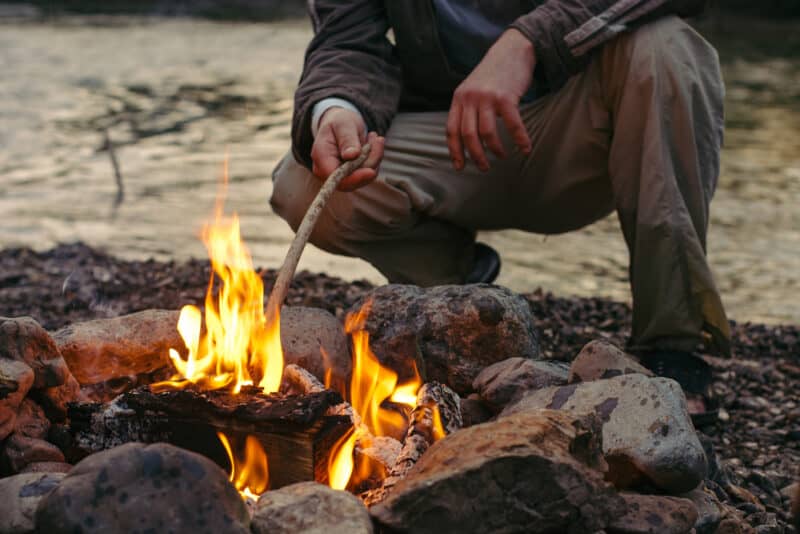
This may be obvious, but it’s easy to forget something and need to quickly run to your supplies to find that missing ingredient or utensil. While you’re gone, a spark jumps out, and pretty soon you’re facing a wildfire.
Don’t let that happen. Make sure there is someone watching the fire at all times.
Have all your ingredients, utensils, and crockery prepared and ready to go by the fire or where you can still monitor it. This is one part of cooking over an open fire that you can’t forget.
14. Control the Heat With Ash
Once your fire is down to coals suitable for cooking, you may find it’s too hot. Rather than wait for it to cool down, since you might wait too long and it gets too cool, sprinkle some ash over the coals. This cools it slightly. Make sure you start with a little bit and build up if necessary.
15. Have the Means to Put Your Fire Out
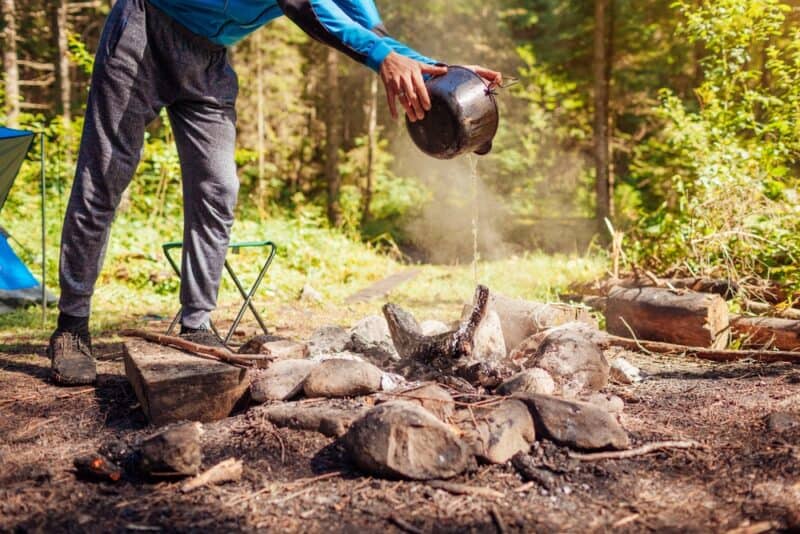
Unless you are using the fire for warmth throughout the night, put your fire out with a lot of water or sand when you’re done.
You should also have water close at hand when you’re cooking over an open fire to put the flames out if they spread somewhere you don’t want them. A fire extinguisher isn’t a bad idea, either.
